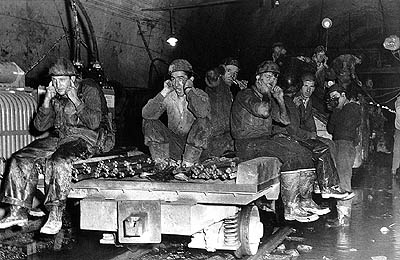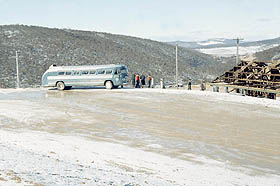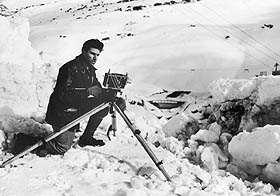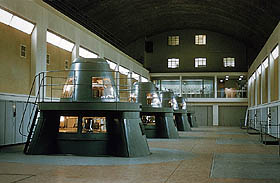|
Sir
William Hudson F.R.S (1896-1978): the first Commissioner
Sir William Hudson was the first commissioner of the
Snowy Mountains Hydro-electric Authority (SMA) 1949-67.
The Commissioner was responsible for the overall management
of the Scheme. He would represent the Scheme at the
highest levels of government, welcome international
scientists and engineers, encourage scientific and engineering
research, as well as involve himself in many social
and civic activities. Sir William implemented a scientific
management approach to leadership, which stressed
cooperation between management and labour and scientific
knowledge (facts) over opinions.

Sir William Hudson (SMA, 1962)
|
Sir
William Hudson was instrumental in introducing and developing
key aspects of the scheme:
- construction
techniques
- the
contract system of engineering construction
- industrial
relations
- industrial
safety
- public
relations
- soil
conservation
- communications.
|
Construction
techniques
In the preliminary planning stages of the Snowy
Mountains
Scheme (SMS) Australian engineers went to America
for short periods of time to study with the United
States Bureau of Reclamation (USBR). In America,
Australian engineers were taught all aspects of
dam design and construction for land reclamation
style projects such as the Snowy Mountains Scheme.
The Scheme gave young Australian engineers a start
in their professional life.
Before
construction work could begin, investigation teams
of geologists, surveyors and hydrologists were
sent up into the mountains to gather information
about topography, rock types and water flows.
|

This photograph shows a diamond
drilling team assembling core samples of granite
in a mountain camp. Samples and data from
the investigation teams were analysed in laboratories
in Cooma. This information was then passed
on to the contractors who were to build the
dams, power stations and tunnels. Photo: SMA
|
|
The
contract system of engineering construction
There were many principal contractors, whose task it
was to complete, within time and on budget, the major
engineering structures including the dams, aqueducts,
tunnels, roads, pressure pipelines, power stations,
pumping stations, turbines and generators, and transmission
lines on the Scheme.
Contractors
Although the Scheme was a federal government venture,
most of the construction was carried out by public works
departments and private firms from Australia and overseas.
They were invited to tender for specific works.
Eucumbene Dam, for example, was contracted to the Public
Works Department of the NSW Government in late 1949.
The
private American contractors Kaiser, Walsh, Perini and
Raymond took over the work in 1956 and it was completed
in 1958. The Americans also introduced (at the insistence
of Sir William Hudson) work regimes that were different
to what the Australian worker (especially labourers)
was accustomed to. For example, long shifts, short tea
and lunch breaks etc, and round the clock, 24
hour, shifts (above and below ground).
Documentation
The project required high quality documentation of:
- designs
- engineering
drawings
- specifications
- tender
documents
- contracts
- management
schedules
|
- planning
and investigating documents
- Gantt
and critical path analysis charts
- maintenance
programs
- work
schedules
- payment
systems
|
Contracts
During the development of the Scheme, many thousands
of contracts were produced. The SMAgained a reputation
for the quality of its contracts. These early documents
were imported from the United States Bureau of Reclamation
(USBR). Contract-development training schemes for engineers
were developed between the SMAand the USBR.
Schedule
of Rates
A standard contract that was developed by the SMA
was the Schedule of Rates. These documents
were comprised of detailed written text, which set
out the work requirements of contractors, and engineering
drawings. The Schedule of Rates contract
was used for the major civil contracts, starting
with Tumut 1 Power Station, Eucumbene-Tumut Tunnel,
and Tumut Pond Dam. |

Courtesy: SMA |
|
Industrial
relations
The arrival of the Americans at Eucumbene signalled
the introduction of "modern" work practices.
Traditional Australian work customs like the smoko
— a break for a cup of tea and cigarette
— were abolished and replaced by longer shifts,
half-hour lunch breaks and a competitive, more
efficient method of work. While they pushed
their workforce very hard, American companies
were thought to provide a better standard of food
and accommodation than other contractors.
A
large percentage of the work force was unionised.
The effective organisation of labour meant that
relatively high rates of pay were awarded to compensate
for the difficult conditions. Most work agreements
were settled by negotiation rather than strike
action.
These
are badges from three of the main unions on the
Scheme: the Australian Workers Union, the more
militant Building Workers Industrial Union and
the Amalgamated Engineering Union, whose slogan
was Educate, Organise, Control. With many
German and Italian carpenters as members, the
Building Workers Industrial Union made a particular
effort to communicate with workers from non-English
speaking backgrounds by printing bilingual articles
in its newspaper. One of its most respected representatives,
Alec Wren, was given the nickname The Man from
Snowy River.
|

The Amalgamated Engineering Union,
the Building Workers Industrial Union and the Australian
Workers Union represented most of the Snowy workers.
Members sometimes wore badges to indicate affiliation
and loyalty. These badges date from the 1960s. Powerhouse
Museum Collection. |
Industrial
safety
Working in the tunnels, driving heavy equipment and
stringing high voltage lines were dangerous occupations.
On the one hand the SMAand contracted companies introduced
comprehensive safety measures, such as the provision
of protective clothing, safety signs and the compulsory
wearing of seat belts. It was the first time many of
these procedures were adopted in Australia.
On
the other hand, rigorous schedules pushed many to exhaustion.
Workers were encouraged to work long shifts in
order to break records and win bonuses for themselves
and their employers. Work often continued around the
clock. This in itself made work more dangerous.
This
photograph shows men employed by the Australian contract
company Theiss Brothers drilling hard rock in the Tumut-Tooma
Tunnel in 1959. They are wearing standard issue hard
hats, rubberised coats and pants and hardened safety
boots.

Photo: SMA |
Industrial
safety concerns were given special attention by management
with the establishment of safety committees and guidelines.
However, these innovations were often introduced as
a result of accidents. A film on trains in tunnels,
for example, was produced as a result of numerous accidents
in the tunnels.
The
hazards of tunnelling
Tunnelling was considered to be the most hazardous of
all the construction operations. The following factors
contributed to a concern for the importance of safe
working conditions:
- underground
blasting
- movement
of large muckers to scoop the fallen rock
- constant
noise of rock drills
- cold,
damp air
- standing
in water for long hours
- working
hundreds of metres below ground surface.

(Raymond, 1999: 51)
|
Lives
lost
Nevertheless, 121 lives were lost during the construction
of the Scheme, 35 in the construction of tunnels and
an unidentified number on the roads. Commissioner Hudson
made the wearing of seatbelts compulsory in 1960 and
this significantly reduced fatalities. The names of
all the workers who died during construction of the
Scheme are on a memorial in Cooma.
Other
workplace issues, such as hearing protection, which
are now addressed in safety guidelines, were not fully
considered in the early days of the Scheme. During blasting
in tunnels, for example, workers blocked their ears
with their fingers, and opened their mouth to prevent
burst eardrums. Breathing apparatuses were not provided
even though the air in the tunnels was thick with dust.
Activity
| 1. |
Identify
and discuss the prime concern for each tunnelling
hazard listed above. |
| 2. |
Identify
examples from the Snowy Mountains Scheme of how
the current National
Occupational Health and Safety Commission
(NOHSC) Hierarchy of controls (the preferred order
of control measures for OHS risks) had been applied.
The Hierarchy of controls are:
| 1. |
Elimination:
controlling the hazard at the source. |
| 2. |
Substitution:
for example, replacing one substance or activity
with a less hazardous one. |
| 3. |
Engineering:
for example, installing guards on machinery
|
| 4. |
Administration:
policies and procedures for safe work practices
|
| 5. |
Personal
protective equipment: for example respirators
and ear plugs. (NOHAC, 2000) |
|
| 3. |
Individual
companies develop their own policies on occupational
health and safety (OH&S). Look at:
OH&S policy http://www.thiess.com.au/index.cfm/how_occhealth/
of Thiess Bros.
OH&S sub-contractor
management |
Public
relations
The SMA was the body established to initiate and administer
construction of the Scheme. Because of the delicate
balance of federal and state government interests, the
vast costs involved and the opposition of some elements
of the press, the Authority quickly realised the need
to sell the Scheme to the public.
Sir
William Hudson initiated a concerted public relations
campaign to make the wonders and benefits of
the Scheme apparent. This was one of the first campaigns
of its kind in Australia. Authority guides led tours
of the Scheme, educational films were produced and thousands
of photographs were taken to win over the Australian
people. Even today the Snowy Hydro places great emphasis
on public relations.
| The
Authority organised its own car tours of the Scheme.
Tourist convoys led by an Authority Volkswagen beetle
were a common sight. Private companies were also
enlisted. Pioneer Tours conducted popular bus tours
of the Scheme in the 1950s and 1960s. This photograph
shows visitors disembarking from a Pioneer bus near
Lake Eucumbene in the 1950s. |

Photo: Bayram Ali (Powerhouse Museum
Collection) |
|
Film
making
This photograph shows Harry Malcolm in the snowfields
with his Cine-Kodak movie camera. Malcolm was
one of a team of film makers and photographers
who documented the Scheme. He began his career
with the legendary Australian film maker Ken Hall
in the 1930s.
In
1962 the Snowy Mountains Hydro-electric Authority
produced a short film, Science Serves the Snowy.
The film shows scientists and engineers at work
during the development of the Scheme.
|

Photo: SMA |
The
film was used in the public relations campaign to convince
an initially sceptical public that the Scheme contributed
to Australia's development. Science and engineering
were activities central to this development.
Holiday
destination
Once the two main reservoirs of the Scheme were
completed, Lakes Eucumbene and Jindabyne were promoted
as popular holiday destinations for boating and
fishing. This photograph shows a boat tour on Lake
Eucumbene in the early 1960s. |

Photo:
Bayram Ali
(Powerhouse Museum Collection) |
Visual
impact
The SMApaid careful attention to the visual impact
of the main Snowy constructions. An aesthetics committee
was established in the 1950s, which comprised Professor
Denis Winston, head of the School of Town Planning at
Sydney University, architect Donald Maclurcan and the
Authority's own Chief Civil Design Engineer Ivor Pinkerton.
Guthega and Murray 1 Power Stations, in particular,
reflected the modernist preference for bold expression
in concrete, steel and glass. Power station interiors
were also important as visitors were frequently guided
through them. Turbine halls, like this one at Tumut
1 Power Station, typically featured a viewing gallery
at one end so visitors could wonder at the display of
high technology.

Photo: Bayram Ali (Powerhouse Museum Collection)
|
Soil
conservation
Senior
engineers were always conscious of soil erosion: 'They'd
rather see us cut tiny tracks than go in with a dozer.
If it looked promising then they'd build the roads
in after.' This concern for soil erosion was not always
in evidence. Wally Wassermann remembers how in the
beginning, the overburden from the construction of
the road into Tumut Ponds was just dumped over the
side of the very steep incline, causing massive erosion.
When the Soil Conservation Service of NSW found out,
he recalls they kicked up a stink that the whole Scheme
was said to be in jeopardy, and it was subsequent
to their intervention that soil conservation measures
were applied assiduously throughout the Scheme. (McHugh,
1989: 71)
In
June 2000 the Snowy Mountains Hydro-electric Authority
achieved certification to the International Standards
Organisation (ISO) 14001 for ongoing environmental management
of the Scheme.
For
further information on soil conservation see Roads.
Communications
Good communications were vital. The Scheme covered a
large undeveloped area. The SMAundertook to provide
an effective communications network and in the process
used some innovative techniques. See Telecommunications.
|